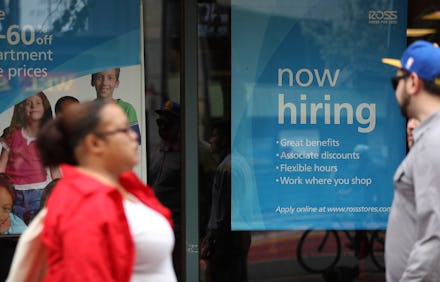The gender wage gap is closing — but not for the reason you think

On Tuesday, the United States Census Bureau released its report on income and poverty in America, in which they revealed quite a nice surprise: Women are closing the pay gap.
According to the report, which examined earnings from 2015 to 2016, the 2016 female-to-male earnings ratio was 0.805, meaning women earned 80.5% of what a man made in a similar role, which marked a 1.1% increase from the 2015 ratio. As the report stated, this is the first time the female-to-male earnings ratio experienced an annual increase since 2007.
Like all good news, this one too comes with many caveats. Let’s break down some good news and bad news within the report.
The good news: As the Washington Post reported, “the typical woman earned $41,554 in 2016 and the average American man took home $51,640.”
The bad news: “Neither sex experienced a statistically significant income jump from the previous year,” according to the Post.
The good news: The median salary for women increased by 2.7% between 2014 and 2016, according to data.
The bad news: One of the reasons the pay gap closed is because the median salary for men in the U.S. only increased by 1.5% over the same period.
The super good news: In the last two years, single mothers and women-led households saw their median salaries skyrocket 7.2%, according to the Washington Post.
The very bad news: The positive news above is really only generally true for white and Asian women. As the Post noted, the census data found that wages for Hispanic women were stagnant, while pay wages for African American women actually declined. In fact, as the Los Angeles Times reported, the data shows that African American households made a median salary of just $39,490 last year, which is actually lower than their average median household salary in 2000, which was $41,363. African Americans represent the only racial group in the report to have not made a leap in pay.
So how can all of this good and terrible news be a part of the same report and be a reality in the same America?
David Wessel, a senior fellow in economic studies at the Brookings Institution, explained in a 2015 blog post that men’s salaries have remained the same since the early 70s, if you account for inflation. Meanwhile, women’s salaries have increased 30% over the same time period because people have accepted women in the workforce and women have accepted nothing less.
Additionally, more women are earning more college degrees than men, leading to higher paying jobs.
“Women are highly invested in their education — more so than men — and this should lead to a relative increase in their earnings,” Ariane Hegewisch, program director for employment and earnings at the Institute for Women’s Policy Research, wrote in an analysis. “The gains overall show important progress, but we must pay close attention to whether these gains are broadly felt, or only felt by certain groups.”
As for black women and minorities making less, that’s systemic racism at its finest.
So when can we expect gender parity in our salaries? Don’t hold your breath for too long, according to the World Economic Forum that won’t happen until the year 2186, a full 169 years from now.